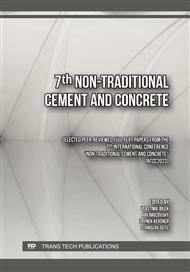p.3
p.19
p.29
p.45
p.55
p.69
p.77
p.87
Effect of Calcium Nitrate on the Performance of Slag Blended Cement
Abstract:
Portland cement has been replaced with 50% ground, granulated blastfurnace slag (ggbs) of two types. The influence of 2 and 4% calcium nitrate accelerator on early hydration of such binders was investigated by isothermal calorimetry as well as X-ray diffraction and thermogravimetry. The strength development of mortar based on these binder blends has been followed up to 28 days and the influence of calcium nitrate discussed. One ggbs lower in SiO2, Al2O3 and MgO yielded somewhat lower strength (about 90%) than the other. Addition of calcium nitrate led to lower strength at 1 day, but higher strength from 3 days on-wards. The blends with the two ggbs achieved similar strength at 7 and 28 days when blended with 4% calcium nitrate. Calcium nitrate led to more ettringite formation and AFm phases (probably nitrate version) at 1-day sealed curing. However, the calcium hydroxide content was reduced. Potential explanations for calcium hydroxide reduction are discussed.
Info:
Periodical:
Pages:
45-54
Citation:
Online since:
March 2024
Authors:
Keywords:
Price:
Сopyright:
© 2024 Trans Tech Publications Ltd. All Rights Reserved
Share:
Citation:


